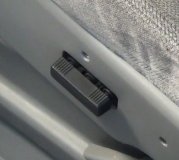Not sure what you mean by "kickback", but that sounds like more than a tune-up issue. It's possible it is related to the tach. An intermittent camshaft position sensor could cause the engine to cut out momentarily and this would show up on the tach. If it suddenly came back to life, the needle of the tach could jump up so quickly it would over shoot.
The tach is not a spring-loaded gauge like they used years ago. It is a computer-controlled stepper motor which has four coils that are alternately pulsed to magnetically position the pointer. Once it has gone over center, and the magnetic fields try to bring it back to zero or idle, the shortest way there is to go clockwise. The magnetic fields don't care which way the pointer turns. Under normal operation, the magnetic fields rise and fall gradually and smoothly so they bring the pointer back down the right way as engine speed slowly goes down.
There are three ways to fix the needle. If you do this quickly, you can raise engine rpm to more than half scale at which point the needle will try to position itself to that reading. Then, it will follow the normal magnetic fields as the engine slows down. If that doesn't work, the Chrysler mechanic will connect their DRB3 hand-held computer, access the instrument cluster which is a computer in itself, and perform the gauge test. That will run every gauge to 1/4, 1/2, 3/4, and full, then slowly back to zero. Once the tach hits full scale, the pointer will follow the commands and slowly come back down. The last alternative is to pull the lens and faceplate off the cluster and just spin the pointer back to zero with your finger.
Caradiodoc
SPONSORED LINKS
Saturday, December 12th, 2009 AT 6:53 AM



